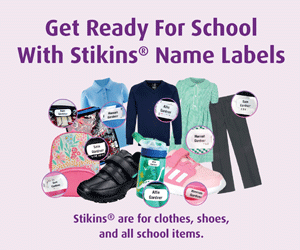Primary Times - the definitive what’s on and where to go family guide of activities and events for children of primary school age. Things to do with your kids during the school holidays including arts and craft activities, music and theatre for children, parties, competitions, days out, and family attractions along with term time drama schools, dance classes, after school clubs and sports activities. Things to do at a place near you!
The Sustainable Fashion Hacks We Can Learn from Baby Boomers
Britons buy five times the amount of clothing they bought in the 1980s*, so environmental charity Hubbub and natural knitwear experts WoolOvers have come together to look at the generational differences in attitudes towards fashion among British women; To explore how attitudes differ by age and what knowledge can be shared.
The survey of 2,000 women by Censuswide, alongside a series of focus groups found that younger women can learn a lot from their mothers’ and grandmothers’ about what makes a good quality product, and how to extend its lifetime through care and repair.
Women aged 54 and above take a much more mindful approach to fashion, spending £49 each on average per month but spreading the cost and only buying a new item of clothing every 3-5 months. And almost two thirds (62%) expect their clothes to last for several years.
Whilst British women aged 16-37 (Generation Z and Millennials) spend on average £81 each per month, with 26% of Generation Z buying new clothing between 2-3 times per month. But not even half of these young women (47%) expect their clothes to last many years, with the quality of the design being prioritised much lower than price and fit.
So what is influencing this difference in attitudes towards buying and caring for clothes between the generations?
One of the biggest impacts is likely the shopping experience itself. A third of Baby Boomers (54-72 year-olds) and the Silent Generation (73 year-olds +), shop seasonally, only 18% of Generation Z do the same, as fast fashion allows them to shop 52 ‘micro seasons’ a year.
With the introduction of online shopping in the late 1990s, young women have gone from being influenced by their mothers and grandmothers on where to shop to having multiple avenues of influence via their phone from apps and social media. Generation Z’s spending is impulsive, with social media and the media playing a big part in influencing them on what to buy. They admit to feeling guilty about the money they have spent and are left stressed that they have spent more than they can afford.
It’s also clear that the implications of buying new clothes this way are not fully understood, despite there being concerns about the environmental implications of fashion, less than half (42%) of Generation Z women know what the term ‘fast fashion’ actually means, compared to more than two thirds - 67% - of Baby Boomers.
Fast fashion items, which are produced rapidly by mass-market retailers in response to the latest trends, are then consequently falling apart, and when clothing become damaged only 30% of Gen Z will repair it themselves, with a quarter asking a friend of relative to fix it for them. Whereas more than half (51%) of Baby Boomers repair their own clothes. This was explored further in the focus groups, which resulted in women admitting that fashion had become so cheap that even sewing a button back on seemed like a useless skill. The main reason for not knowing how to repair clothing being down to whether or not they were taught how to by a family member or at school.
“In a world where sustainable living is so high on the agenda, the fashion industry is somehow still getting away with a ‘business as usual’ approach. While some retailers have introduced ethical lines, people still do not feel educated on the environmental impact of the industry and so are prioritising price and convenience over sustainability. Our research shows that the Baby Boomers and Silent Generation seem to hold the secret to how to buy good quality items and if needed, repair them to extend their lifetime. We need to get women across the UK talking and sharing these invaluable skills and insights, in a bid to tackle the damaging effects of fast fashion.” Heather Poore, Creative Director at Hubbub
“The relationship between generations is important: young women often learn their first style lessons from their mothers and grandmothers while daughters educate their elders on new fashion trends. However, little is known about what older women’s think about the environmental impact of fashion and how and whether they are communicating on this with younger women, so it was something we were keen to explore. It’s clear just how much attitudes differ between the generations and the valuable knowledge mothers and grandmothers can pass on to young women to help them make a positive impact on both their bank balance and the environment.” Mike Lester, CEO WoolOvers
To help pass the knowledge on, Hubbub and WoolOvers have collated some of the Baby Boomers’ fashion advice in a series of tips and infographics – see below. They are also encouraging people to speak to their parents, grandparents, uncles and aunties for advice on quality, care and repair.
Baby Boomer Sustainable Fashion Hacks
Buy Less
Unfortunately, we can’t buy our way into sustainability. The best thing to reduce fashion’s impact on the environment is to buy less in the first place! It’ll save you money and you might just fall in love with something you already have. Put time aside to have a root around your wardrobe, knowing what you already have will also allow you to shop more mindfully when you do need something new.
Choose Better Quality Clothes
If you need to buy something new, try to invest in good quality clothes that are made to last. Here are some top tips on what to look out for:
Check the label
Look out for clothes made from responsibly sourced fibres. Words like “recycled” or “organic” are good things to look out for. Natural fabrics like wool can be good as they need less washing and are longer lasting
Avoid multi blend fabrics
Clothes made of mix blends are more likely to break down quickly and are difficult to recycle
Not keen for a sheer look?
Check if it is see-through by holding it up to the light. No one wants to realise that they have to find special nude underwear just to wear their new dress
Does it come with spare buttons etc?
That’s a good sign it’s been made to last and means you can easily repair it if needed.
Think about your wardrobe before buying
Will it go with other things you already have? Can you imagine wearing it 30 times? If not, best to leave it on the rail
Make Your Clothes Last
- Sometimes the lazy way is the best way! The more we wash our clothes, the faster they break down. Avoid over washing by spot washing small marks and airing your clothes by a window to freshen up smells
- Use the Delicate or Wool wash on washing machines rather than hand wash as its better for clothes
- Check the fabric care instructions eg Merino wool should only be washed every 3 to 4 months. This will help you avoid shrinking or fading your clothes
- Avoid the tumble dryer and air dry instead. Your clothes will last longer
- Find your local cobblers to get shoes re-soled and re healed when they need it. This won’t cost you a lot but will allow you to wear your shoes for longer.
Pass it on
- Have a look through your wardrobe. If there are items you haven’t worn in the last year, it might be time to pass them on. Organising a swap with friends, dropping items off at local donation banks or selling on online marketplaces are just some of the ways you can give forgotten items a new lease of life
- When clothes and accessories get beyond repair don’t chuck in the bin, cut up and use as rags for cleaning, old fabrics for cushion covers, head scarfs etc or recycle them in a clothes bank
For more information and tips on sustainable fashion, visit tiny.cc/HubbubFashion and https://www.woolovers.com/microplastics




